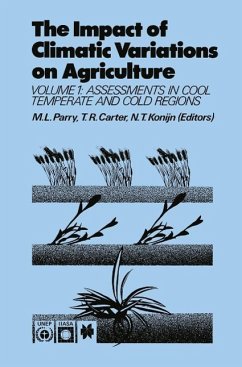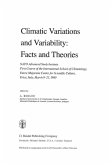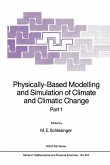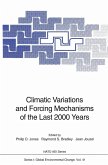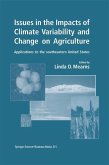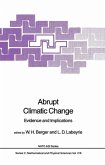Three important studies were initiated in the 1970s to investigate the relation ship between climatic variations and agriculture: by the National Delcnse University (1980) on Crop Yields and Climate Change to the Year 2000, by the U.s. Department of Transportation (1975) on Impacts of Climatic Change on the Biosphere and by the U.S. Department of Energy (1980) on Environmental and Societal Consequences of a Possible CO -Induced Climatic Change (the ClAP 2 study). These were pioneering projects in a young field. Their emphasis was on measuring likely impacts of climatic variations rather than on evaluating possible responses, and they focused on first-order impacts (e.g., on crop yields) rather than on higher-order effects on society. A logical next step was to look at higher-order effects and potential responses, as part of a more integrated approach to impact assessment. This was undertaken by the World Climate Impact Program (WCIP), which is directed by the United Nations Environment Program (UNEP). The WCIP is one of four aspects of the World Climate Program that was initiated in 1979. At a meeting in 1982, the Scientific Advisory Committee of WCIP accepted, in broad terms, a proposal from the International Institute for Applied Systems Analysis (IIASA) for an integrated climate impact assessment, with the proviso that the emphasis be on impacts in the agricultural sector. Martin Parry was asked to design and direct the project at IIASA. Funding was provided by UNEP, IIASA, the Austrian Government and the United Nations University.
Dieser Download kann aus rechtlichen Gründen nur mit Rechnungsadresse in A, B, BG, CY, CZ, D, DK, EW, E, FIN, F, GR, HR, H, IRL, I, LT, L, LR, M, NL, PL, P, R, S, SLO, SK ausgeliefert werden.
'It is an admirable book in its breadth and depth. It is authoritative, up-to-date, extensively referenced and illustrated. There are many tables of data ... Put it high on your list of recommendations for library purchase.' -- E. Linacre, Australian Geographer, November 1989
'... this is a book which should be read by all planners and policy makers as well as agricultural scientists who are endeavouring to have a complete knowledge of their subject.' -- W.J. Ridgman, Journal of Agricultural Science, Vol. 113, 1989
'In addition this volume contains a lot of data about climatic and other site factors influencing biomass production as well as about economic conditions in the different regions. Together with volume 2 this volume provides an important basis for ecologists as well as for economists for studying the interaction between climate and plant growth and biomass production in the different regions of the world.' -- Agroforestry Systems, 10, 1990
'... this is a book which should be read by all planners and policy makers as well as agricultural scientists who are endeavouring to have a complete knowledge of their subject.' -- W.J. Ridgman, Journal of Agricultural Science, Vol. 113, 1989
'In addition this volume contains a lot of data about climatic and other site factors influencing biomass production as well as about economic conditions in the different regions. Together with volume 2 this volume provides an important basis for ecologists as well as for economists for studying the interaction between climate and plant growth and biomass production in the different regions of the world.' -- Agroforestry Systems, 10, 1990
`It is an admirable book in its breadth and depth. It is authoritative, up-to-date, extensively referenced and illustrated. There are many tables of data ... Put it high on your list of recommendations for library purchase.'
E. Linacre, Australian Geographer, November 1989
`... this is a book which should be read by all planners and policy makers as well as agricultural scientists who are endeavouring to have a complete knowledge of their subject.'
W.J. Ridgman, Journal of Agricultural Science, Vol. 113, 1989
`In addition this volume contains a lot of data about climatic and other site factors influencing biomass production as well as about economic conditions in the different regions. Together with volume 2 this volume provides an important basis for ecologists as well as for economists for studying the interaction between climate and plant growth and biomass production in the different regions of the world.'
Agroforestry Systems, 10, 1990
E. Linacre, Australian Geographer, November 1989
`... this is a book which should be read by all planners and policy makers as well as agricultural scientists who are endeavouring to have a complete knowledge of their subject.'
W.J. Ridgman, Journal of Agricultural Science, Vol. 113, 1989
`In addition this volume contains a lot of data about climatic and other site factors influencing biomass production as well as about economic conditions in the different regions. Together with volume 2 this volume provides an important basis for ecologists as well as for economists for studying the interaction between climate and plant growth and biomass production in the different regions of the world.'
Agroforestry Systems, 10, 1990

